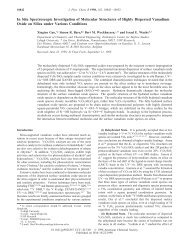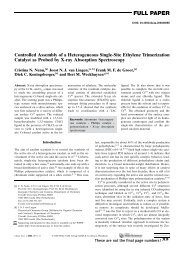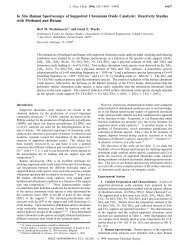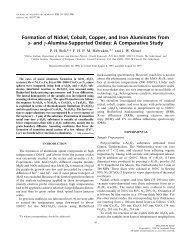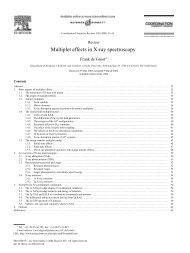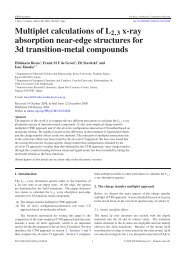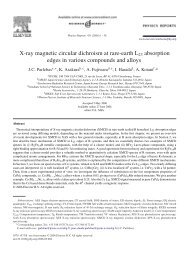View - Inorganic Chemistry and Catalysis
View - Inorganic Chemistry and Catalysis
View - Inorganic Chemistry and Catalysis
Create successful ePaper yourself
Turn your PDF publications into a flip-book with our unique Google optimized e-Paper software.
J. Phys. Chem. B 1997, 101, 2793-2796<br />
2793<br />
In Situ Raman Spectroscopy of Supported Chromium Oxide Catalysts: 18 O 2 - 16 O 2 Isotopic<br />
Labeling Studies<br />
Bert M. Weckhuysen * ,† <strong>and</strong> Israel E. Wachs<br />
Zettlemoyer Center for Surface Studies, Department of Chemical Engineering, Lehigh UniVersity, 7 Asa DriVe,<br />
Bethlehem, PennsylVania, 18015<br />
ReceiVed: October 8, 1996; In Final Form: December 30, 1996 X<br />
The isothermal isotopic exchange reaction of 18 O 2 with 16 O of chromium(VI) oxide supported on zirconia,<br />
alumina, <strong>and</strong> titania has been investigated with in situ laser Raman spectroscopy. The isotopic exchange<br />
reaction is dependent on the support type, the Cr loading, <strong>and</strong> the reaction temperature. Complete isotopic<br />
exchange of chromium(VI) oxide with 18 O 2 is difficult to achieve <strong>and</strong> requires several successive butane<br />
reduction- 18 O 2 oxidation cycles at relatively high temperatures. The efficiency of the isothermal isotopic<br />
exchange reaction increases from alumina over titania to zirconia <strong>and</strong> with increasing Cr loading <strong>and</strong> reduction<br />
temperature. The observed Raman shifts upon isotopic labeling are consistent with a mono-oxo surface<br />
chromium oxide(VI) species.<br />
Introduction<br />
Raman spectroscopy (RS) is a powerful characterization<br />
technique for studying supported chromium oxide catalysts<br />
because it can discriminate between the different molecular<br />
structures of surface chromium(VI) oxide species (e.g. monochromate<br />
versus dichromate). 1 In previous RS studies, supported<br />
chromium oxide catalysts were extensively studied under<br />
hydrated <strong>and</strong> dehydrated conditions as a function of the support<br />
type. 2-7 The characterization studies revealed that under<br />
hydrated conditions the molecular structure of the surface<br />
chromium oxide species is determined by the iso-electric point<br />
of the oxide support. Thus, the monochromate/polychromate<br />
ratio increases with the iso-electric point of the support <strong>and</strong> with<br />
decreasing Cr oxide loading. Upon calcination, dehydrated<br />
surface chromium(VI) oxide species are formed by reaction with<br />
the surface hydroxyl groups of the support. Two surface<br />
chromium oxide species were observed on the TiO 2 , ZrO 2 , <strong>and</strong><br />
Al 2 O 3 surfaces: a monomeric species (characterized by a CrdO<br />
stretching frequency at ∼1030 cm -1 ) <strong>and</strong> a polymeric species<br />
(possessing a CrdO stretching frequency at ∼1005-1010 cm -1<br />
<strong>and</strong>aCr-O-Cr bending mode at ∼880 cm -1 ). 8<br />
The exact molecular structure of these dehdydrated surface<br />
chromium oxide species, however, remains unclear. 1,8 Two<br />
tetrahedral structures, as shown in Figure 1 for a monomeric<br />
species, were previously proposed from RS data: a mono-oxo<br />
species with one terminal CrdO bond <strong>and</strong> three Cr-O-support<br />
bonds (structure A) <strong>and</strong> a di-oxo species with two terminal<br />
CrdO <strong>and</strong> two Cr-O-support bonds (structure B). The<br />
objective of the present investigation is to resolve this issue by<br />
combining in situ Raman spectroscopy with oxygen-18 isotopic<br />
labeling studies. In addition, the efficiency of the isotopic<br />
exchange reaction has been studied as a function of the Cr<br />
loading, the support type, <strong>and</strong> the reaction temperature. The<br />
new insights will be used (1) to develop a more detailed<br />
underst<strong>and</strong>ing of the molecular structures of supported chromium<br />
oxides <strong>and</strong> (2) to obtain knowledge about the surface<br />
mobility of oxygen species on the surfaces of supported<br />
* To whom correspondence should be addressed.<br />
† Present address: Centrum voor Oppervlaktechemie en Katalyse,<br />
Departement Interfasechemie, Katholieke Universiteit Leuven, Kardinaal<br />
Mercierlaan 92, 3001 Heverlee, Belgium.<br />
X Abstract published in AdVance ACS Abstracts, February 1, 1997.<br />
S1089-5647(96)03101-X CCC: $14.00<br />
Figure 1. Molecular structure of a supported monochromate species:<br />
(a) mono-oxo species <strong>and</strong> (b) di-oxo species.<br />
chromium catalysts. This mobility of oxygen species plays an<br />
important role in catalysis, not only in the catalytic cycle itself<br />
but also during activation <strong>and</strong> regeneration treatments of<br />
catalysts. 9<br />
Experimental Section<br />
1. Catalyst Preparation <strong>and</strong> Characterization. The 1, 3,<br />
<strong>and</strong>6wt%CrO 3 /ZrO 2 (Degussa, 39 m 2 /g), 5 wt % CrO 3 /Al 2 O 3<br />
(Harshaw, 180 m 2 /g), <strong>and</strong> 3 wt % CrO 3 /TiO 2 (Degussa P-25,<br />
55 m 2 /g) catalysts were prepared by the incipient-wetness<br />
impregnation method with an aqueous solution of chromium<br />
nitrate (Cr(NO 3 ) 3 ‚9H 2 O, Allied Chemical Co.). Additional<br />
details about these supported chromium oxide catalysts can be<br />
found elsewhere. 5 After impregnation, the wet samples were<br />
initially dried at room temperature for 16 h, further dried at<br />
110-120 °C for 16 h, <strong>and</strong> then calcined at 500 °C for 16 h.<br />
2. Raman Spectroscopy <strong>and</strong> Sample Treatment. Raman<br />
spectra of the supported chromium oxide catalysts were obtained<br />
with a laser Raman apparatus with the 514.5 nm line of an Ar +<br />
laser (Spectra Physics, Model 171) as the excitation source. The<br />
laser power at each sample was about 40 mW. The scattered<br />
radiation from the sample was directed into a Spex Triplemate<br />
spectrometer (Model 1877) coupled to a Princeton Applied<br />
Research (Model 1463) OMA III optical multichannel photodiode<br />
array detector (1024 pixels). The detector was cooled<br />
thermoelectronically to -35 °C to decrease the thermal noise.<br />
The Raman scattering in the 600-1100 cm -1 region was<br />
collected, <strong>and</strong> the spectra were recorded using an OMA III<br />
computer <strong>and</strong> software. The instrument resolution was experimentally<br />
determined to be better than 2 cm -1 . About 0.2 g of<br />
each supported chromium oxide catalyst was pressed into a thin<br />
wafer of about 1 mm thickness. The catalyst samples were<br />
calcined in dry air at 500 °C for 2 h before the Raman<br />
measurements in order to minimize possible sample fluores-<br />
© 1997 American Chemical Society
2794 J. Phys. Chem. B, Vol. 101, No. 15, 1997 Weckhuysen <strong>and</strong> Wachs<br />
Figure 2. In situ Raman spectra of the 6% CrO 3/ZrO 2 catalyst after<br />
calcination (a) <strong>and</strong> after butane reduction at 450 °C (b).<br />
cence. The in situ Raman spectra were obtained with the<br />
following procedure. The samples were placed into the cell<br />
<strong>and</strong> heated up to 500 °C for2hinaflow of pure oxygen gas<br />
(Linde Specialty Grade, 99.99% purity). The Raman spectra<br />
of the dehydrated samples were then collected after cooling the<br />
sample to 200 or 350 °C in a flow of pure oxygen gas for 30<br />
min. Flowing of pure 18 O 2 only gives rise to small changes in<br />
the Raman spectra of the calcined Cr catalyst. Thus, a reduction<br />
step is crucial to incorporate 18 O in the supported chromium<br />
oxide species. Therefore, butane (Air Products <strong>and</strong> Chemicals,<br />
mixture of 98.7% He <strong>and</strong> 1.3% butane) was dynamically<br />
introduced at high temperature into the cell, <strong>and</strong> the Raman<br />
spectra were collected. The reduced samples were then reoxidized<br />
in 18 O 2 (JWS Technologies, Inc., Matheson, <strong>and</strong> 18 O 2 /He<br />
) 3/97). This reduction-reoxidation cycle for each catalyst<br />
was repeated until the extent of oxygen-18 isotopic exchange<br />
was maximized. 10 The maximum number of reductionreoxidation<br />
cycles for complete isotopic exchange of the<br />
supported chromium oxides decreases with increasing reduction<br />
<strong>and</strong> reoxidation temperature. The optimal reduction <strong>and</strong> reoxidation<br />
temperatures were determined to be 450 °C.<br />
Results<br />
As an example we will discuss the in situ Raman spectra of<br />
the6wt%CrO 3 /ZrO 2 catalyst in great detail. The spectrum<br />
obtained after calcination in 16 O 2 is shown in Figure 2. The<br />
spectrum is dominated by three strong Raman peaks at 1030,<br />
1010, <strong>and</strong> 880 cm -1 , which were previously assigned to terminal<br />
CrdO vibrations of monochromate (1030 cm -1 ) <strong>and</strong> terminal<br />
CrdO <strong>and</strong> bridging Cr-O-Cr vibrations of polychromate<br />
species (1010 <strong>and</strong> 880 cm -1 ), respectively. 8<br />
After calcination, the samples were cooled down <strong>and</strong><br />
contacted with butane gas in the absence of oxygen at 450 °C.<br />
The corresponding RS spectrum is included in Figure 2. The<br />
Raman active surface Cr 6+ species is reduced to surface Cr 3+<br />
<strong>and</strong> Cr 2+ species. The stretching modes of Cr 2+ -O 2- or Cr 3+ -<br />
O 2- peaks are Raman active, but are much less intense with<br />
respect to those of Cr 6+ -O 2- . They are also located at lower<br />
Figure 3. In situ Raman spectra of the 6% CrO 3/ZrO 2 catalyst as a<br />
function of the number of butane reduction- 18 O 2 reoxidation cycles<br />
(X) with X ) (a) 1; (b) 3; (c) 6; <strong>and</strong> (d) 9.<br />
Figure 4. In situ Raman spectra of the 6% CrO 3/ZrO 2 catalyst as a<br />
function of the number of butane reduction- 18 O 2 reoxidation cycles<br />
(X) with X ) (a) 11; (b) 15; (c) 17; <strong>and</strong> (d) 19.<br />
frequencies <strong>and</strong> are therefore masked by the vibrational modes<br />
of the support.<br />
After recalcination in 18 O 2 at 450 °C, the following spectra<br />
features are observed: (1) decrease of the Raman peaks at 1030,<br />
1010, <strong>and</strong> 880 cm -1 ; (2) broadening of the 880 cm -1 Raman<br />
peak; <strong>and</strong> (3) formation of a new Raman peak at around 970<br />
cm -1 . After repeating this reduction-reoxidation cycle 18<br />
times, the RS spectra change drastically, as illustrated in Figures<br />
3-4: (1) the intensity of the Raman peak at 970 cm -1 further<br />
increases; (2) the Raman peaks at 1030 <strong>and</strong> 1010 cm -1 further
Spectroscopy of Supported Chromium Oxide Catalysts J. Phys. Chem. B, Vol. 101, No. 15, 1997 2795<br />
Discussion<br />
1. Isotopic Exchange Reaction: Efficiency <strong>and</strong> Mechanism.<br />
Our experiments clearly show that a high number of<br />
redox cycles <strong>and</strong> severe reduction conditions are necessary for<br />
an almost complete oxygen-18 isotopic exchange reaction. The<br />
efficiency of the isotopic exchange reaction seems to be support<br />
<strong>and</strong> treatment dependent, <strong>and</strong> this observation suggests that the<br />
oxygens of the support are playing an important role in the<br />
exchange process. This merits a more detailed discussion.<br />
Isotopic exchange studies on oxides have been done in the<br />
1950s <strong>and</strong> 1960s by Nováková, Winter, <strong>and</strong> Boreskov. 11-16 They<br />
have shown that the oxygen atoms of the inorganic oxides such<br />
as ZrO 2 , TiO 2 , <strong>and</strong> Al 2 O 3 undergo isotopic labeling with 18 O 2<br />
at relatively high temperatures. According to Boreskov 15,16 <strong>and</strong><br />
Nováková, 11,12 three types of exchange reactions could occur<br />
on oxide surfaces:<br />
[ 16 O] s + 18 O 2 T 16 O 18 O + [ 18 O] s (1)<br />
2[ 16 O] s + 18 O 2 T 16 O 2 + 2[ 18 O] s (2)<br />
16 O 2 + 18 O 2 T 2 16 O 18 O (3)<br />
Figure 5. In situ Raman spectra of the 6% CrO 3/ZrO 2 catalyst as a<br />
function of the number of butane reduction- 18 O 2 reoxidation cycles<br />
(X) with X ) (a) 21; (b) 23; <strong>and</strong> (c) 25.<br />
decrease with respect to the initial intensity as obtained after<br />
calcination in pure oxygen; (3) the Raman peak at 880 cm -1<br />
shifts to lower energy; <strong>and</strong> (4) a new weak b<strong>and</strong> at around 990<br />
cm -1 is formed. After 25 reduction-reoxidation cycles, almost<br />
complete oxygen-18 isotopic exchange is achieved <strong>and</strong> the<br />
Raman spectrum is characterized by absorptions at 1030, 1010,<br />
990, 970, <strong>and</strong> 840 cm -1 (see Figure 5). The Raman peaks at<br />
1030 <strong>and</strong> 1010 cm -1 , however, are very weak. It appears that<br />
the 990, 970, <strong>and</strong> 840 cm -1 Raman peaks are formed at the<br />
expense of the 1030, 1010, <strong>and</strong> 880 cm -1 Raman peaks from<br />
the oxygen-18 isotope exchange.<br />
The same results were obtained for the 1 <strong>and</strong> 3 wt % CrO 3 /<br />
ZrO 2 catalysts; however, more reduction-reoxidation cycles<br />
were necessary to achieve complete oxygen-18 isotopic exchange.<br />
It seems that the efficiency of the isotopic exchange<br />
reaction increases with increasing Cr loading.<br />
Similar oxygen-18 isotopic exchange results are obtained for<br />
the3wt%CrO 3 /TiO 2 catalyst (not shown for brevity). The<br />
initial RS spectrum after calcination in 16 O 2 is also characterized<br />
by three Raman peaks at 1030, 1010, <strong>and</strong> 880 cm -1 . These<br />
Raman peaks decrease in intensity after reducing the sample<br />
with butane, followed by recalcination in 18 O 2 at 450 °C. In<br />
addition, the b<strong>and</strong> at 880 cm -1 shifts to lower energy values.<br />
After applying 25 reduction-reoxidation cycles, a RS spectrum<br />
almost identical to the 6 wt % CrO 3 /ZrO 2 catalyst is obtained,<br />
but the Raman peak intensities are always much weaker. The<br />
oxygen-18-exchanged RS spectra of the 5 wt % CrO 3 /Al 2 O 3<br />
catalyst, obtained after successive butane reduction- 18 O 2 oxidation<br />
cycles are also very similar (not shown for brevity). The<br />
initial RS spectrum after calcination in 16 O 2 is dominated by<br />
three Raman peaks at around 1005, 990, <strong>and</strong> 800 cm -1 . The<br />
Raman peaks at around 1005 <strong>and</strong> 990 cm -1 decrease in intensity<br />
at the expense of a new Raman peak at 970 cm -1 after the<br />
reduction-reoxidation cycles at 450 °C. Thus, essentially the<br />
same main spectral features are observed for CrO 3 /Al 2 O 3 as for<br />
the CrO 3 /ZrO 2 <strong>and</strong> CrO 3 /TiO 2 catalysts; however, the CrO 3 /<br />
Al 2 O 3 Raman spectra are always noisy <strong>and</strong> more difficult to<br />
interpret.<br />
s indicating support <strong>and</strong> reaction 1 always dominant for the<br />
supports under investigation.<br />
In addition, 18 O 2 reoxidizes the reduced Cr n+ species (obtained<br />
after reduction with butane) on the support, according to<br />
[Cr n+ ] s + m 18 O 2 f [Cr 6+ - 18 O x ] s (4)<br />
with n indicating oxidation state (n < 6) <strong>and</strong> s, surface.<br />
Our experiments show that reactions 1 <strong>and</strong> 4 take place<br />
because (a) an increase of the oxide coverage by CrO 3<br />
(increasing Cr oxide loading) <strong>and</strong> (b) an increase of the reduction<br />
temperature (more [Cr n+ ] s ) result in a reduction of the number<br />
of reduction-reoxidation cycles necessary for complete isotopic<br />
exchange. In other words, reaction 4 becomes dominant over<br />
reaction 1 for increasing Cr oxide loading <strong>and</strong> reduction<br />
temperature.<br />
It is clear that supports with a lower surface area (i.e. ZrO 2<br />
<strong>and</strong> TiO 2 ) give rise to better resolved RS spectra after isotopic<br />
exchange because they are more covered by CrO 3 . The presence<br />
of some fluoresence for the CrO 3 /Al 2 O 3 catalyst may originate<br />
from the residual hydrocarbon on the alumina surface due to<br />
the strong Lewis acid sites present on this support. The<br />
necessity of a large number of reduction-reoxidation cycles<br />
for complete isotopic labeling also implies that the surface<br />
oxygens of the support <strong>and</strong> the supported chromium oxides are<br />
highly mobile <strong>and</strong> can be interchanged. Direct evidence for<br />
such a spillover effect comes form a recent study of Martin<br />
<strong>and</strong> Duprez for Rh supported catalysts. 9<br />
2. Molecular Structure of Supported Chromium Oxide<br />
Species. The present oxygen-18 isotopic exchange experiments<br />
provide fundamental information about the number of terminal<br />
CrdO bonds, mono-oxo versus di-oxo (see Figure 1), present<br />
in the isolated <strong>and</strong> polymerized surface chromium oxide species.<br />
For the supported chromium oxide catalysts containing comparable<br />
amounts of the two oxygen isotopes, a mono-oxo should<br />
give rise to two strong vibrations, Crd 16 O <strong>and</strong> Crd 18 O, <strong>and</strong><br />
a di-oxo structure should exhibit three strong vibrations,<br />
16 OdCrd 16 O, 18 OdCrd 18 O, <strong>and</strong> 16 OdCrd 18 O, the latter is<br />
expected to be predominant. Furthermore, a Raman peak
2796 J. Phys. Chem. B, Vol. 101, No. 15, 1997 Weckhuysen <strong>and</strong> Wachs<br />
characteristic of a Cr-O simple oscillator will lead to an isotopic<br />
ratio calculated as<br />
ν(Cr- 16 O)<br />
ν(Cr- 18 O) ) [( 1<br />
52 + 1<br />
18) 1/2<br />
/( 1<br />
52 + 1<br />
16)] (5)<br />
of 0.9566. For the polymerized surface chromium oxide species,<br />
only two strong Raman peaks are observed after oxygen-18<br />
isotopic exchange at 1010 <strong>and</strong> 970 cm -1 , <strong>and</strong> the third strong<br />
b<strong>and</strong> expected at around 990 cm -1 for a di-oxo structure is not<br />
observed. The observed isotopic shift of 40 cm -1 is close to<br />
the theoretical shift of 44 cm -1 . The weak Raman peak present<br />
at 990 cm -1 is associated with the isolated surface chromium<br />
oxide species. It is always possible that if the bond angle in a<br />
CrO 2 group is near 90° <strong>and</strong> for an appropriate interaction force<br />
constant between the two CrdO groups, then only one new<br />
Raman peak would be observed on total oxygen-18 isotope<br />
exchanged Cr systems. However, its seems rather unlikely that<br />
this would arise together on ZrO 2 , TiO 2 , <strong>and</strong> Al 2 O 3 surfaces.<br />
For the isolated surface chromium oxide species, two weak<br />
Raman peaks are observed at 1030 <strong>and</strong> 990 cm -1 , <strong>and</strong> the third<br />
b<strong>and</strong> for a di-oxo structure would be expected at around 1010<br />
cm -1 . However, the strong 1010 cm -1 Raman peak for the<br />
polymeric surface chromium oxide species occurs at this location<br />
<strong>and</strong> prevents discrimination between mono-oxo <strong>and</strong> di-oxo<br />
structures for the isolated surface chromium oxide species based<br />
on isotopic oxygen exchange experiments. The observed<br />
isotopic shift of the 1030 cm -1 Raman peak (40 cm -1 ), however,<br />
is close to the expected shift of 45 cm -1 .<br />
Summarizing, the isotopic oxygen exchange experiments<br />
reveal that the polymeric surface chromium oxide species<br />
possesses a mono-oxo structure. Additional experiments are<br />
required for the structural determination of the isolated surface<br />
chromium oxide species because of its weak Raman signal, but<br />
such experiments will be possible only if one can selectively<br />
reduce the polymeric species so that Raman spectroscopy shows<br />
only the isolated species. This, however, will be a difficult task.<br />
Additional evidence for the proposed molecular structures<br />
can be found in an earlier publication of our group, in which<br />
dehydrated Raman <strong>and</strong> IR spectra of supported chromium oxide<br />
catalysts are compared. 5 The relative intensities of the 1030<br />
<strong>and</strong> 1010 cm -1 Raman <strong>and</strong> IR b<strong>and</strong>s are the same, which is<br />
consistent with mono-oxo structures since di-oxo structures<br />
would give rise to more intense CrdO symmetric vibrations in<br />
the Raman <strong>and</strong> more intense CrdO antisymmetric vibrations<br />
in the IR. 17 Furthermore, the IR overtone region only exhibits<br />
two b<strong>and</strong>s due to CrdO vibrations, 1986-1995 <strong>and</strong> 2010-<br />
2015 cm -1 , which is only consistent with two mono-oxo surface<br />
chromium oxide species since di-oxo species would give rise<br />
to three combination b<strong>and</strong>s (symmetric, antisymmetric, <strong>and</strong> a<br />
combination mode). 17 Thus, the oxygen-18 isotopic exchange<br />
experiments <strong>and</strong> the corresponding in situ Raman/IR measurements<br />
are consistent with the mono-oxo structure for the isolated<br />
as well as polymerized surface chromium oxide species. Such<br />
detailed structural information is new <strong>and</strong> could not be obtained<br />
in the past by other spectroscopic techniques, like diffuse<br />
reflectance spectroscopy. 18-21 It is also important to mention<br />
here that the presence of mono-oxo surface species is also<br />
revealed by a combination of IR spectroscopy <strong>and</strong> oxygen-18<br />
isotopic exchange experiments in Cr 2 O 3 , MoO 3 /SiO 2 , SO 4 /<br />
Al 2 O 3 , <strong>and</strong> SO 4 /TiO 2 , <strong>and</strong> V 2 O 5 /TiO 2 catalysts. 22-25<br />
Conclusions<br />
Combined in situ laser Raman spectroscopy <strong>and</strong> oxygen-18<br />
labeling studies is a powerful technique for the elucidation of<br />
the molecular structure of chromium oxide structures supported<br />
on ZrO 2 , TiO 2 , <strong>and</strong> Al 2 O 3 . The present investigation reveals<br />
that supported chromium oxide species possess, independent<br />
of their polymerization degree, a mono-oxo structure. Complete<br />
isotopic exchange with 18 O 2 is difficult to achieve <strong>and</strong> several<br />
successive butane reduction- 18 O 2 oxidation cycles at relatively<br />
high temperature are required. The support oxide, the reaction<br />
temperature, <strong>and</strong> the Cr loading seem to have a strong influence<br />
on the efficiency of the isotopic exchange process.<br />
Acknowledgment. B.M.W. acknowledges the National Fund<br />
of Scientific Research (NFWO) of Belgium for a postdoctoral<br />
fellowship <strong>and</strong> for a travel grant to visit the Zettlemoyer Center<br />
for Surface Studies at Lehigh University. This work was<br />
supported by the Division of Basic Energy Sciences, Department<br />
of Energy (Grant DEFG02-93ER14350).<br />
References <strong>and</strong> Notes<br />
(1) Weckhuysen, B. M.; Wachs, I. E.; Schoonheydt, R. A. Chem. ReV.<br />
1996, 96, 3327.<br />
(2) Kim, D. S.; Tatibouet, J. M.; Wachs, I. E. J. Catal. 1992, 136,<br />
209.<br />
(3) Kim, D. S.; Wachs, I. E. J. Catal. 1993, 142, 166.<br />
(4) Vuurman, M. A.; Wachs, I. E. J. Phys. Chem. 1992, 96, 5008.<br />
(5) Vuurman, M. A.; Wachs, I. E.; Stufkens, D. J.; Oskam, A. J. Mol.<br />
Catal. 1993, 80, 209.<br />
(6) Ianibello, A.; Marengo, S.; Tittarelli, P.; Morelli, G.; Zecchina, A.<br />
J. Chem. Soc., Faraday Trans. 1 1984, 80, 2209.<br />
(7) Richter, M.; Reich, P.; Ohlmann, G. J. Mol. Catal. 1988, 46, 79.<br />
(8) Weckhuysen, B. M.; Wachs, I. E. J. Phys. Chem. 1996, 100, 14437.<br />
(9) Martin, D.; Duprez, D. J. Phys. Chem. 1996, 100, 9429.<br />
(10) An oxygen leak, as detected by mass spectrometry, was smaller<br />
than 1% of the gas composition in the Raman cell. This leak must be<br />
responsible for the incomplete reduction of supported chromium(VI) oxide<br />
even at relatively high temperatures, as evidenced by the presence of weak<br />
RS b<strong>and</strong>s of Cr 6+ (see also the reported Raman spectra in ref 8). These<br />
traces of oxygen-16 may interfere with the reduction-reoxidation cycles<br />
applied to the supported chromium oxide catalysts.<br />
(11) Klier, K.; Nováková, J.; Jiru, P. J. Catal. 1963, 2, 479.<br />
(12) Nováková, J. Catal. ReV. 1970, 4, 77.<br />
(13) Winter, E. R. S. AdV. Catal. 1985, 10, 196.<br />
(14) Winter, E. R. S. J. Chem. Soc. 1968, 1, 2889.<br />
(15) Boreskov, G. K. AdV. Catal. 1964, 15, 285.<br />
(16) Boreskov, G. K.; Muzykantov, V. S. Ann. New York Acad. Sci.<br />
1973, 213, 137.<br />
(17) Nakamoto, N. Infrared <strong>and</strong> Raman spectroscopy of inorganic <strong>and</strong><br />
coordination compounds, 3rd ed.; Wiley: New York, 1978.<br />
(18) Weckhuysen, B. M.; Schoonheydt, R. A.; Jehng, J. M.; Wachs, I.<br />
E.; Cho, S. J.; Ryoo, R.; Kijlstra, S.; Poels, E. J. Chem. Soc., Faraday<br />
Trans. 1 1995, 91, 3245.<br />
(19) Weckhuysen, B. M.; De Ridder, L. M.; Schoonheydt, R. A. J. Phys.<br />
Chem. 1993, 97, 4756.<br />
(20) Weckhuysen, B. M.; Verberckmoes, A. A.; Buttiens, A. L.;<br />
Schoonheydt, R. A. J. Phys. Chem. 1994, 98, 579.<br />
(21) The diffuse reflectance spectra of dehydrated supported chromium<br />
oxide catalysts are always explained in terms of a chromate or a<br />
polychromate species, i.e., a tetrahedral Cr species with two CrdO bonds<br />
<strong>and</strong> two Cr-O-X bonds with X either a support atom (chromate) or another<br />
Cr atom (polychromate). The present characterization results are not in<br />
line with this view. To resolve the assignments of the diffuse reflectance<br />
spectra, we have attempted CASSCF/CASPT2 calculations on these systems<br />
(in collaboration with Professor Kristine Pierloot of the <strong>Chemistry</strong> Department<br />
of the K. U. Leuven). These attempts, however, failed because of<br />
the complexity of the calculations.<br />
(22) Carrot, P. J. M.; Sheppard, N. J. Chem. Soc., Faraday Trans. 1<br />
1983, 79, 2425.<br />
(23) Cornac, M.; Janin, A.; Lavalley, J. C. Polyhedron 1986, 5, 183.<br />
(24) Saur, O.; Bensitel, M.; Mohammed Saad, A. B.; Lavalley, J. C.;<br />
Tripp, C. P.; Morrow, B. A. J. Catal. 1986, 99, 104.<br />
(25) Oyama, S. T.; Went, G. T.; Lewis, K. B.; Bell, A. T.; Somorjai, G.<br />
A. J. Phys. Chem. 1989, 93, 6786.



